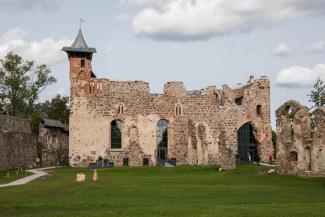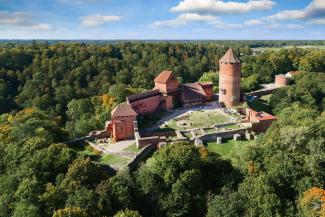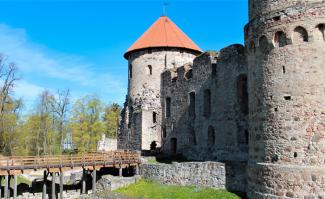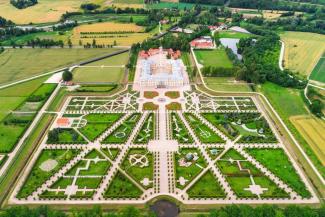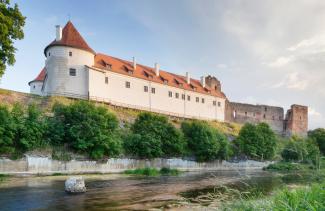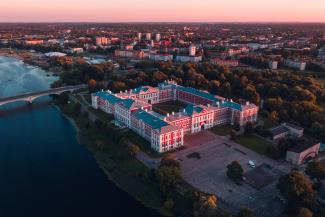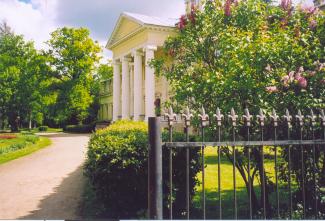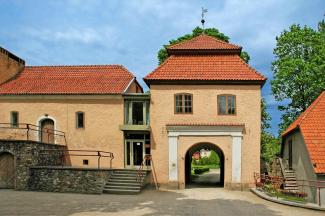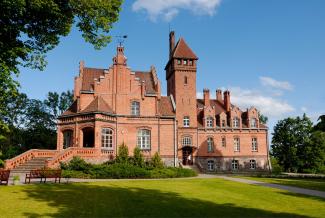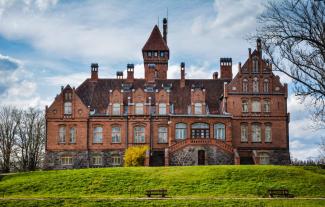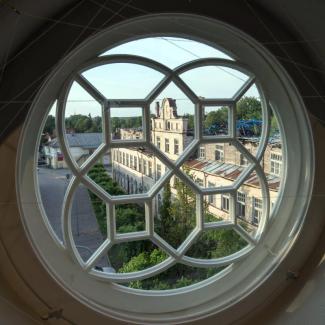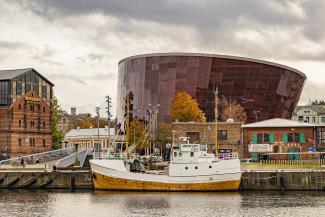Castles, palaces and manors are unique places in the history of any nation; they present evidence of special achievements. It can be architecture, a grand garden, a whole complex of buildings or the lasting contribution of glorious historical figures. In addition, it is often a set of several things in castles, palaces and manors. They attract distant travelers to their premises and allow locals to get to know their roots better. Although Latvia has had its fair share of historical challenges, Latvians can be proud that more than 100 castles, palaces and manors have been preserved. You can learn more about them here, while here we have listed Latvian castles, palaces and manors where you can stay overnight. But that's not all there is to enjoy! In several castles, palaces and manors, the owners have thought about entertainment and leisure opportunities that allow you to test your strength, learn about the history and discover something new. We have compiled a list of everything you can do in castles, palaces and manors.
Familiarise yourself and go find out!
The stone castle of the Livonian Order is the oldest building in Dobele and a cultural monument of national importance. Since 2002 the architect Pēteris Blūms has been working on the vision of the preservation and development of the Dobele Livonian Order Castle complex, so that it gets a new lease of life, but preserves the evidence of history. At the moment, it is possible to view both permanent and changing expositions in the castle and go on both individual and group tours accompanied by a guide.
Visitors can also try their hand at the themed adventure game The Lost Medallion of the Duchess. The adventure game route includes places where visitors are not allowed. True history explorers might like the workshop Ancient trades or work and tool, which is dedicated to learning about ancient trades and tools. In addition, the excitement of real treasure hunters can be felt in the museum programme Archaeological story of Dobele Castle, which allows everyone to try their hand at improvised excavations.
In Turaida Museum Reserve, it is possible to familiarise yourself with expositions on the history of archaeology, culture and art, which tell visitors about events starting from the 11th century. Many stories are stored here: about the medieval castle and church, the Libyans of the Gauja, the ancient centre of the manor and Dainu Hill. The Museum Reserve holds a lot: both stories and historical evidence. It is impossible to tell you all of this in one tour, so in the Turaida Museum Reserve you can focus on various topics accompanied by a tour guide, learn the legend of the Rose of Turaida and walk various trails. You can get to know special routes by participating in the orienteering game Millennium Story.
The most active people can try their hand at archery or making coins. On the other hand, for those who want to be alone, Turaida Museum Reserve offers you to find out more about the historical buildings and environment using an audio guide, which is available on the mobile app. Getting to know the Museum Reserve will also be made more exciting by the quiz Walk with questions, which is available on the app.
During the 800 years of its existence, the meaning of Cēsis Medieval Castle has changed as significantly as its external appearance. The castle was built in around 1214 and originally served as a residence for the Knights of the Livonian Brothers of the Sword, but during the reign of its next owner, the Teutonic Order, gained the fame of the most powerful fortress in Livonia. Nowadays, it is possible to engage in various activities that allow you to get to know the deep history of the castle and the region better. For example, the tour will be led by a servant dressed in medieval costume, accompanied by whom it is possible to go for a walk in the Castle Garden, learn the secrets of the castle, the history of its creation and many interesting facts about life in the Middle Ages.
Also, accompanied by a guide, you can find out more not only about the Medieval castle, but also the Cēsis castle manor house and Cēsis. But the most special tour will definitely be Torchlight tour of Cēsis. On a stroll through Cēsis at night you will discover the magic of the town, walking through the town’s cobbled streets, illuminated parks and squares in the light of torches. Before visiting, please note that tours must be booked at least three days prior to arrival.
The Rundāle Palace ensemble is the most outstanding monument of Baroque and Rococo architecture in Latvia, built from 1736 to 1740 as the summer residence of Ernst Johan von Biron, Duke of Courland - a favourite of Empress of Russia Anna Ioannovna (Anna Ivanovna). The palace was built according to the project of the famous Russian court architect Franchesco Bartolomeo Rastrelli. The entire Rundāle Palace complex is a must-see: the palace, its architecture and interior, the Palace Garden, a vault, fountains, amphitheatre and museum. In addition, it is possible to find out more about all the tourist attractions by participating in various activities.
The palace tour guides offer various tours, as well as a specially theatrical tour, where the guides welcome guests in historical costumes. The territory of the palace ensemble is vast, so an exciting way to get to know it is a tour with an electric car and an audio guide. For those who want to experience aristocratic feelings, it is possible to dance a waltz in the White Hall to the accompaniment of On the Blue Danube by Johann Strauss or a piece of your own choice. The palace is also open for photo sessions. Whereas in the museum, it is possible to test your abilities in various orienteering games both in the palace premises and in the French Garden.
The Bauska Castle ensemble has two parts. The oldest part, the Castle of the Livonian Order, was built in the middle of the 15th century, but only ruins of it have survived to the present day. The newest part of the castle ensemble is the residence of the Ketlers - the Dukes of Courland, and it was built at the end of the 16th century. This building is located in a scenic location where two rivers, the Mūsa and Mēmele, meet. A lot can be said about Bauska Castle, but it is best to see it with your own eyes and indulge in the various activities.
Nowadays, in the Castle of the Livonian Order it is possible to learn the art of court dances and to get to know the dances of the Renaissance era more closely, accompanied by a teacher. If dancing is not to your liking, you can also try on Renaissance costumes at Bauska Castle and learn about the culture of dressing at the court of the Duchy of Courland (Kurzeme). In addition, those who enjoy a more lazy life might like the workshop Court domestic culture in the late 16th century and early 17th century, during which you can learn more about culture, traditions, games, the way of doing things and manners, as well as taste traditional dishes prepared according to ancient recipes and served in replicas of dishes found by archaeologists. All these activities are worth visiting and should be booked prior to your visit to Bauska Palace.
Jelgava Palace is the most significant early work of architect Francesco Bartolomeo Rastrelli, and one of the few historic architectural landmarks to be preserved to this day in Jelgava. Since 1968 a museum is located at Jelgava Palace. In the exposition of the history of the palace, you can find out more about the history of the construction of the old Livonian Order Palace and the current palace, as well as learn about the achievements in the historical research and preservation of the castle. Jelgava Palace offers an exclusive opportunity for groups, or as a part of wedding events, a themed evening with Duchess Dorothea.
It is an entertaining and educational programme in which Dorothea, Dorothea of Courland (Duchess of Kurzeme and Zemgale), will let you feel the atmosphere of the 19th century, learn the secrets of calligraphy and prepare a surprise for your loved ones by sending a personal letter written by hand and sealed with a lacquer signet. An aristocratic activity with friends or family is the gourmet programme Hot Chocolate with Fruit at the Duke's Residence, where everyone is served hot chocolate made according to a special recipe. For those who want to experience special feelings, it is possible to participate in the annual Christmas party in Jelgava Palace.
Krimulda Manor was built in 1822 as the residence of Princess Lievens. In the manor complex you can see the steward's house, a carriage house, a granary, a dry-house and a Swiss house with expressive and unique wood carvings. It is located in a picturesque place in the Gauja Valley and offers visitors the pleasures of nature, culture and taste.
For the curious, a guided tour of the historical centre of Krimulda Manor is available, including the medieval castle ruins, the Krimulda Swiss house and Manor Park. For those who love a healthy lifestyle, it is possible to get to know Krimulda Manor as a place where even nature and air heal. Both on a walk through the Manor Park and in the rooms of the manor, you will have the opportunity to get to know medicinal plants and get information about the use of wild and indoor plants for your health. On the excursion, gourmands will be able to find out more about the territory of the manor and domestic stories, as well as taste wine and biscuits.
Šlokenbeka Manor is one of the rare examples of a fortified medieval manor in the Baltics and the only one in Latvia that has been preserved to this day. It houses the Latvian Road Museum, a hotel and a cultural centre; moreover, tourists have an opportunity to engage in various educational and challenging activities. For example, the relay of the ancient manor allows you to get to know the wooden games of ancient times in an attractive way.
After physical activities, an interesting and attractive guided tour of the manor's historical trails and rooms is possible with the enjoyment of special treats. Afterwards, in the 400 year old cellar of Šlokenbeka Manor, you can get to know and taste the wines made by various Kurzeme winemakers in a special atmosphere.
Jaunmoku Palace is a masterpiece of Neo-Gothic architecture, built in 1901 according to the project of the Baltic German architect Wilhelm Bockslaff. A stove with unique paintings of views of Riga has been preserved in the palace. Nowadays, the Forest Museum is located in the palace, where you can view an exposition dedicated to Latvian forestry and hunting.
In the palace, it is possible to see the museum exposition, go on various tours accompanied by a guide or enjoy solitude and listen to an audio guide. But especially aristocratic feelings can be enjoyed on the English Tea Afternoon programme, during which you will find out more about the culture of enjoying tea in the best English traditions, as well as enjoy tea and traditional snacks prepared by the chef. For families the most exciting way to get to know the palace will be the orienteering competition, where you have to decipher specific objects in the palace and their location based on photos. In the basement of Dairy House in Jaunmoku Palace, a breakout room Black stories of the Green Forest has been created. Entering the Beast’s Cave, the participants of the game solve seven tasks to save the forest inhabitants trapped in the man-made waste and get out of the cave themselves. It is an exciting, educational game for players of all generations, especially children and youth.

